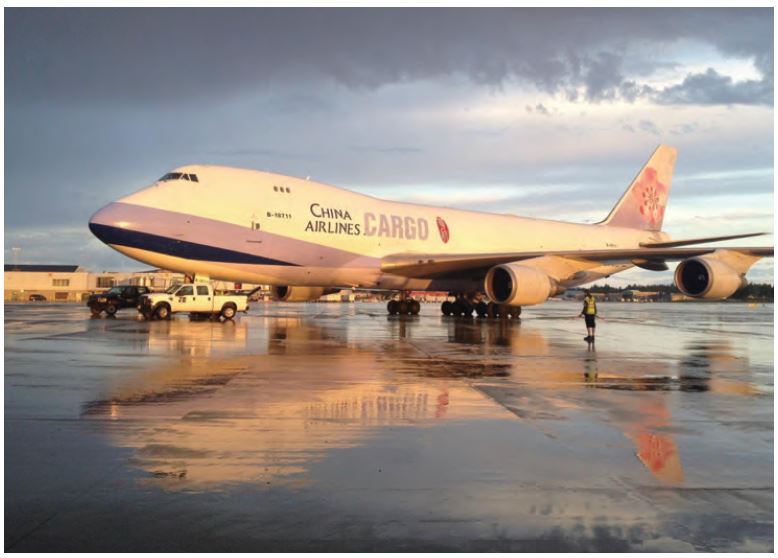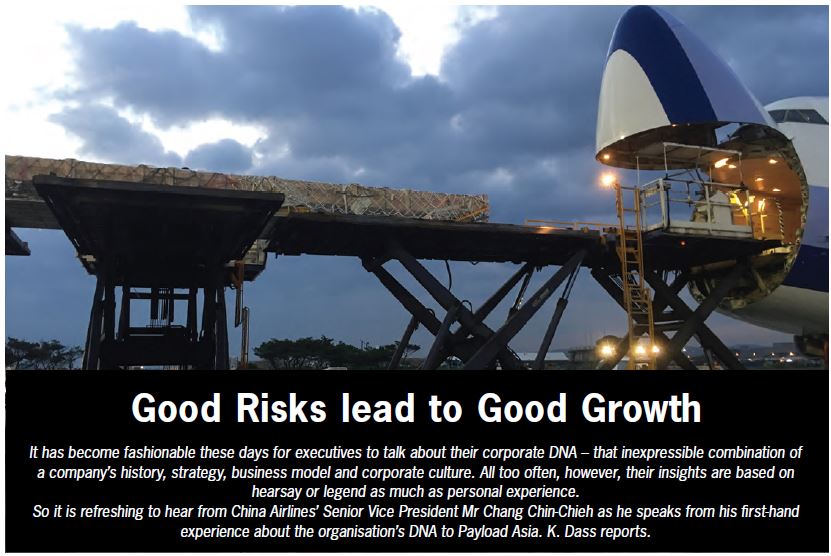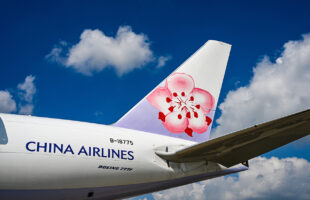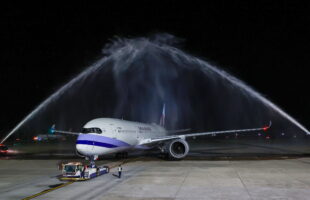

The airline signed a multi-year IMS contract with Airbus subsidiary, Satair Group for a long-term, fully-integrated end-to-end supply chain package covering expendable material for the airline’s Airbus fleet of A330-300s and A350- 900s. Meaning, Satair Group will fully manage its planning, sourcing, purchasing, logistics, and inventory management covering some 18,000 part numbers. Coverage includes all expendables materials needs of China Airlines and is extendable to affiliates as well.
This leaves the airline to focus on its core business of serving passengers’ needs and entrust operational support activities such as material management to experts. The implementation foresees a reduction in total operation cost and higher availability of material at the time of need and thus, resulting in premium flight quality service its passengers and cargo customers.
Seeing a steady growth in its phar-maceutical sector, the Taiwanese airline with 152 destinations in 27 countries has established a comprehensive network serving this industry around the world. The airline signed a master lease agree-ment with CSafe Global to offer transport and leasing services for the CSafe RKN active temperature controlled container on China Airlines flights. Hence, the airline’s healthcare and phar-maceutical customers who require strict temperature control of their products during transport will benefit from access to CSafe’s industry-leading cold chain technology and global customer support.
With the steady growth in air cargo, please share how China Airlines has performed during 2017. Are there specific milestones China Airlines has achieved in this time period?
The Cargo Volume (FRTK) grew 5.20 per cent since January to June 2017 compared to the same period in 2016, with the overall loading rate increasing by 3.25 ppt to 72.01 per cent, and the cargo revenue grew by 16.58 per cent.
The general air transport business was relatively smooth this year with further compliments from the emergence of charters. For example, last year there were Coldplay, Circus of the Sun and other performance equipment charter flights.
The second half of the year (2017) based on the Q4 traditional season was better than the first half of the year, with a further boost coming from the beginning of August from Wafer Equip-ment Charter, 3C new products (such as Samsung/ Apple), and the high speed growth of electricity and other logistics. Before the end of the year it was clear that the performance was beyond our expectation.
In terms of cargo fleet, taking into consideration the cost of maintenance, after decontamination considerations, the company continued to introduce a new generation of wide-body aircraft A350 to increase belly capacity. This maintains the storage of three cargo capacity, and 18 aircraft.
The company is also committed to strengthening the status of Taiwan’s transport hub to enhance the competi-tiveness of freights in order to sustain development, while continuing to pro-mote e- transport, carrying forward the spirit of green enterprises, protecting the Earth’s environment and energy saving carbon reduction efforts.

In a competitive market, what would you say is the main component that gives China Airlines an edge? What strategy(s) have you adopted to differentiate?
There are several attributes that have given China Airlines the edge.
- High efficiency and realising the advantages of the freighter fleet: China Airlines owns 21 Boeing B747-400F freighter aircraft, one of the largest fleets of this aircraft type in the world. According to the latest IATA statistics, China Airlines was ranked among the top ten by International Air Cargo in 2016. We were ranked seventh in the world by Freight Tonne Kilometres (FTK) and tenth in the world by Freight Revenue Tonne Kilometres (FRTK).
- Flexible network for optimal flight yields: The airlines capacity is adjusted on the fly based on market changes in the region. In August 2016 for example, the Delhi route was extended to Eu-rope to strengthen the development of the emerging market in India; in Asia, different destinations were connected based on the type of demand (Singapore-Manila, Penang – Singapore) to boost product returns from inter-regional direct flights and improve the economic performance of each flight.
- Track the trends and expanding cargo revenues: The airline continues to develop the delivery of special cargo including high-precision semi-conductor equipment, engines and aerospace materials, cool-chain products, and live animals. In terms of e-commerce, and online shop-ping sources, apart from cooperating more closely with courier services, we are also investing in the development of the postal packaging business in response to the growth of cross-border e-commerce. This includes freight- to-post services in Taiwan, expansion of the station partnership with China Post, and increase in postal shipments for Vietnam and Malaysia. To improve the quality of our temperature-controlled cargo services, we applied for IATA CEIV certification this year, enhancing our professional reputation on PHAMA deliveries. Certification should be issued this year.
- Improving unit revenues, strengthening cargo capacity and yield management: Our network capacity is adjusted as necessary to satisfy customer require-ments, improve cargo load factor and boost unit revenues; we are also con-tinuing to enforce capacity and yield management to make the most use of hold resources and each stations’ cargo sources. These efforts will help to boost returns from flights and the network.
- Professionalism, improved service quality and electronic integration: China Airlines has long provided professional education and training to all of its cargo personnel around the world. Basic/advanced cargo courses, aircraft loading, and transportation of hazardous products are undertaken not only by IATA-accredited instructors at the training centre but also delivered online through e-learning courses and case studies.These improve the professional stand-ards of our employees and the overall quality of cargo services. The overhaul of the cargo website as well as continued support for e-AWB and other electronic services are being used to satisfy the demand for real -time and mobile commerce from our customers.
What are the main cargo commodities you carried last year compared to the same period in 2016? What are the differentiation’s?
China Airlines pioneered Taiwan’s air cargo market. It has built a strong reputation for delivering goods and live animals requiring special handling. We have helped many tech companies from Europe, the US, and Japan to relocate their entire plants by air. We have also delivered high value precision instru-ments and temperature controlled drugs. China Airlines was chosen to transport “Formosat-5”, Taiwan’s first domestically designed satellite.
China Airlines also made a break-through in the transport of medicine and biotechnology. The transportation of temperature controlled containers containing Ad immune vaccines and Savoir Lifetec antibiotics demonstrated the quality of services and brand image of China Airlines cargo services.
Innovation plays a big part in the entire supply chain. What are some of the recent innovations / techno-logical enhancements that you have implemented to better serve clients and make internal processes more efficient?
We have introduces a revenue management (RM) system in 2014. The system can prioritise the operation of our air freight service based on the latest information of our markets around the world. The system can also help headquarters in Taiwan to make timely adjustments. We also developed free-sell systems to go with the RM system, which is able to effectively and largely raise the company’s revenue on our more popular routes. We will continue to study whether to upgrade the RM system in the future.

With the growth of e -commerce and worldwide customer demands from the East to the West, how much has this affected your tonnage compared to other years? How are you leveraging on this opportunity and what strategies have you put in place to keep up with the demands?
With the drastic change in sales channels over the past years, many goods that were previously shipped by sea are now insisting on air shipment since customers demand to receive them sooner. This increases the need for air freight activity.
The double digit growth of postal and express delivery over the past year is the major momentum that drives the growth of air freight services. Such growth is most obvious in China, US and Europe. Currently, postal and express delivery only stands about 10 per cent of our company’s air freight service. Given the ongoing growth, we are closely monitoring the business.
What challenges do you foresee the cargo industry will face in the coming months (beginning of 2018)? How do you plan to overcome these challenges?
Through different product mixes for the advantages of loading and 3C prod-ucts in the trend of light and thin. The full use of air cargo aircraft and the lower deck of the carrier space is still the issue of 2018.
Looking forward to 2018, IMF and World Bank expect the growth of the economy to be better than 2017. To maintain last year’s high load and revenue growth is still a challenge in the years to come. In the face of possible fluctuations in demand and space supply in the air market, the company is still focusing on optimising freight transport, air and freight management. In addition to improving the product mix, we will also expand the proportion of high yield sources such as pharmaceutical biotechnology products, air materials and special goods.
As for future planning, we will strengthen the international courier industry, post office; logistics service providers, United Airlines / union (sky team cargo) to fight for the highly developed cross body electricity supply sources.
In addition, the service will be dedicated to the integration of the air cargo operators (airlines, freight forwarders, warehouse and transport operators) operating system to provide customers with timely information on the whole situation; in addition to the transport process of e / paperless for the next few years.








